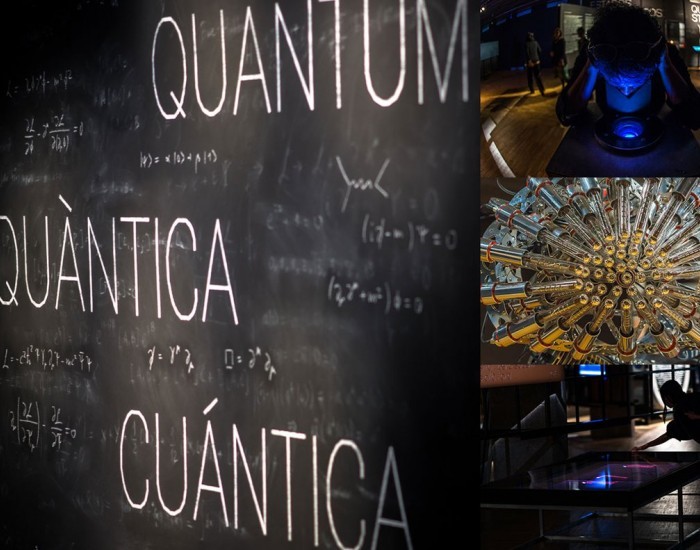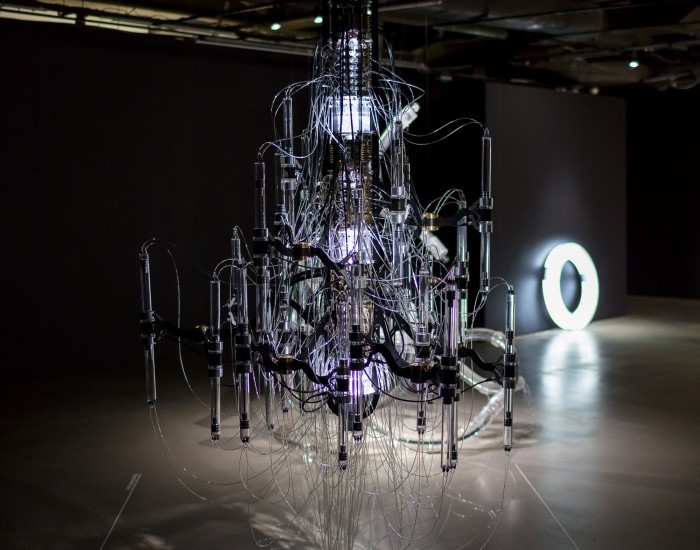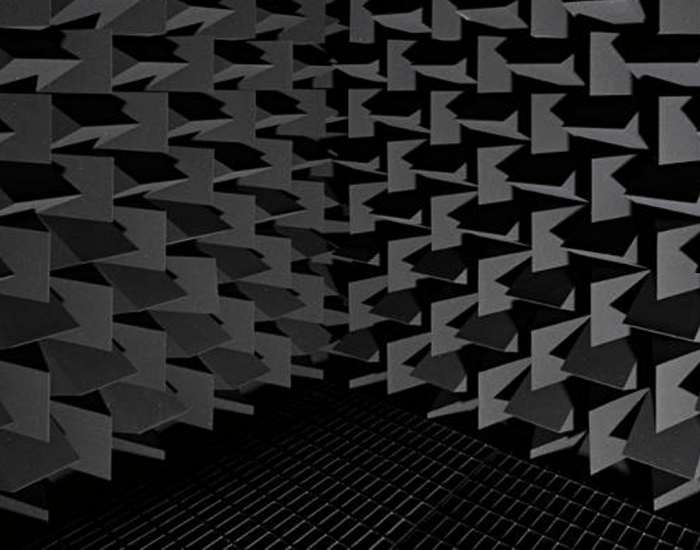Newsroom
Newsroom
Black Quantum Futurism agitan la escena barcelonesa de arte y ciencia de la mano del CERN.
Over the past hundred years or so, artists and scientists have come to follow increasingly common paths, from exploration to research to discovery, and from production to dissemination, first within their communities and then across broader society.
Two artists are presenting their work inspired by their research at CERN at the V&A exhibition “Alice: Curiouser and Curiouser”
Black Quantum Futurism spoke to El País about their practice, their incoming residency at CERN and Barcelona, and their Collide project 'CPT Symmetry and Violations'.
Miquel Molina writes on the art and science scene in Barcelona and highlights the exhibition Arts at CERN: when art and particle physics collide at CosmoCaixa during the City and Science Biennial.
Carroll’s polymathic mind finds its emblem in a carousel of Victorian novelties: theodolite, kaleidoscope, daguerreotype, dodo. His heroine debates concepts about logic and language like a junior Wittgenstein. Matter, space and time are all explored as the rabbit tries to catch up with himself and Alice alternately shrinks and grows. A film by the German artist Mariele Neudecker centres on the so-called Alice experiment at Cern, where the tiniest particles in the universe are studied with the largest machines.
88 metres underground, in the labyrinth of chambers and corridors of the world's large particle accelerator, art and science collide in wild and wonderful ways.
Join Natasha Mitchell at CERN in Geneva, Switzerland, in search of two artists on the loose.
GUESTS:
Jarman says Cern scientists have welled up on stepping into Halo, apparently perceiving in it a simulation of the elegance they find in equations and theories. “For me,” says Professor Antonella De Santo, the Sussex University physicist involved in the project, “this is the first time I have sensed the scientific beauty I experience in my career in artistic form.” She tells me she stood at the centre of Halo with her eyes closed and felt she heard the rhythm of matter formation expressed as sound.
But what really plunged me down the rabbit hole was a film by artist Mariele Neudecker revealing that Cern has a physics experiment going on that it calls Alice – A Large Ion Collider Experiment. This is a nice literary crossover, as the experiment frees quarks from their bonds – quarks being a word invented by James Joyce, whose nonsense masterpiece Finnegans Wake is a Carroll homage. From psychedelia to avant garde cuisine to quantum physics, Alice has come to symbolise how, in Slick’s words, “logic and proportion have fallen sloppy dead”.
Ahead of the V&A's landmark Alice in Wonderland exhibition, deputy editor of Elephant Magazine Louise Benson takes a rare visit to Cern and explores the surprising connection between Lewis Carroll’s story and quantum physics.
The implicit message of human smallness in a vast universe is an upshot of the time Ikeda spent at Cern. “The mecca of particle physics” turned him, he freely admits, into something of an “anti-humanist”. Handed a set of keys and the freedom to roam the labs at will, he felt that the quest to resolve the mystery of the universe was premised on blind faith: the research performed by the scientists is “completely invisible”, so “unthinkably small that they can’t see it or touch it”.
The exhibition also includes a film (by Mariele Neudecker) that transports visitors to the subterranean wonderland of the ALICE experiment in the Hadron Collider (the world's largest and highest-energy particle collider and the largest machine in the world) at CERN (the European Organisation for Nuclear Research).
Resident Advisor (International) – Moor Mother & Rasheedah Phillips' Black Quantum Futurism awarded residency at CERN, the world's largest particle physics lab
Art & Education (International) – Black Quantum Futurism wins the Collide Residency Award
Artist and composer Yunchul Kim spoke to Nature about his Collide residency at CERN, the artworks resulting from his research in the Laboratory, and his experience working with Helga Timko, a CERN accelerator physicist at CERN.
"The Museum of Black Hole Spacetime grew out of a residency at the European Organization for Nuclear Research (Cern) in Geneva. 'One can look at much art practice as emanating from thought processes which access deeper levels of consciousness and which, as Bruce Nauman suggested, may reveal mystic truths,' she says.
La Vanguardia (Spain) – Convocan el premio Collide de residencia artistica en Barcelona y el CERN
The International Journal of Music (International) – International Open Call: Collide Residency Award
'Last spring, I began a residency at CERN, where I investigated the holographic principle, an interest of mine for quite a few years. When three-dimensional objects enter a black hole, they apparently leave a two-dimensional equivalent of themselves on the event horizon around it. This, if you are a theoretical physicist, leads you to deduce that reality is holographic.
A travelling art exhibition entitled ‘Quantum/Broken Symmetries’* will bring the fruit of CERN’s art and science residencies to four new museums worldwide in 2020: iMAL in Brussels, National Taiwan Museum of Fine Arts in Taichung, Le lieu unique in Nantes and Kumu Art Museum in Tallinn.
Geneva, 16 October 2018.
What happens when scientists and artists collide? Artworks resulting from three years of collaboration between physicists and Collide International artists-in-residence at CERN, the world’s largest particle physics laboratory, will be exhibited at Broken Symmetries in FACT Liverpool, UK, from 22 November 2018 to 3 March 2019. Broken Symmetries comprises artworks by 10 international artists that delve into scientific fact and challenge our perception of reality by performing or interrogating theories and experiments.
An article by Tara Joshi on the occassion of the launch of the new art commission at Lighthouse, Brighton.
CERN scientists want artists to shed new light on the Universe's biggest questions
South Korean artist Yunchul Kim—winner of CERN’s COLLIDE International Award 2016—makes art through a process that physicists can relate to.
Geneva, 6 April 2017. Arts at CERN is delighted to announce the winners of the four artist residency awards for 2017: the studio hrm199 led by artist Haroon Mirza, Laura Couto Rosado, Cheolwon Chang and Tomo Savić-Gecan.
Arts at CERN is CERN’s arts and science programme, fostering dialogue between prominent scientists and visionary artists at the world’s leading centre for particle physics.
The European Center for Nuclear Research is calling for art submissions for its annual award


